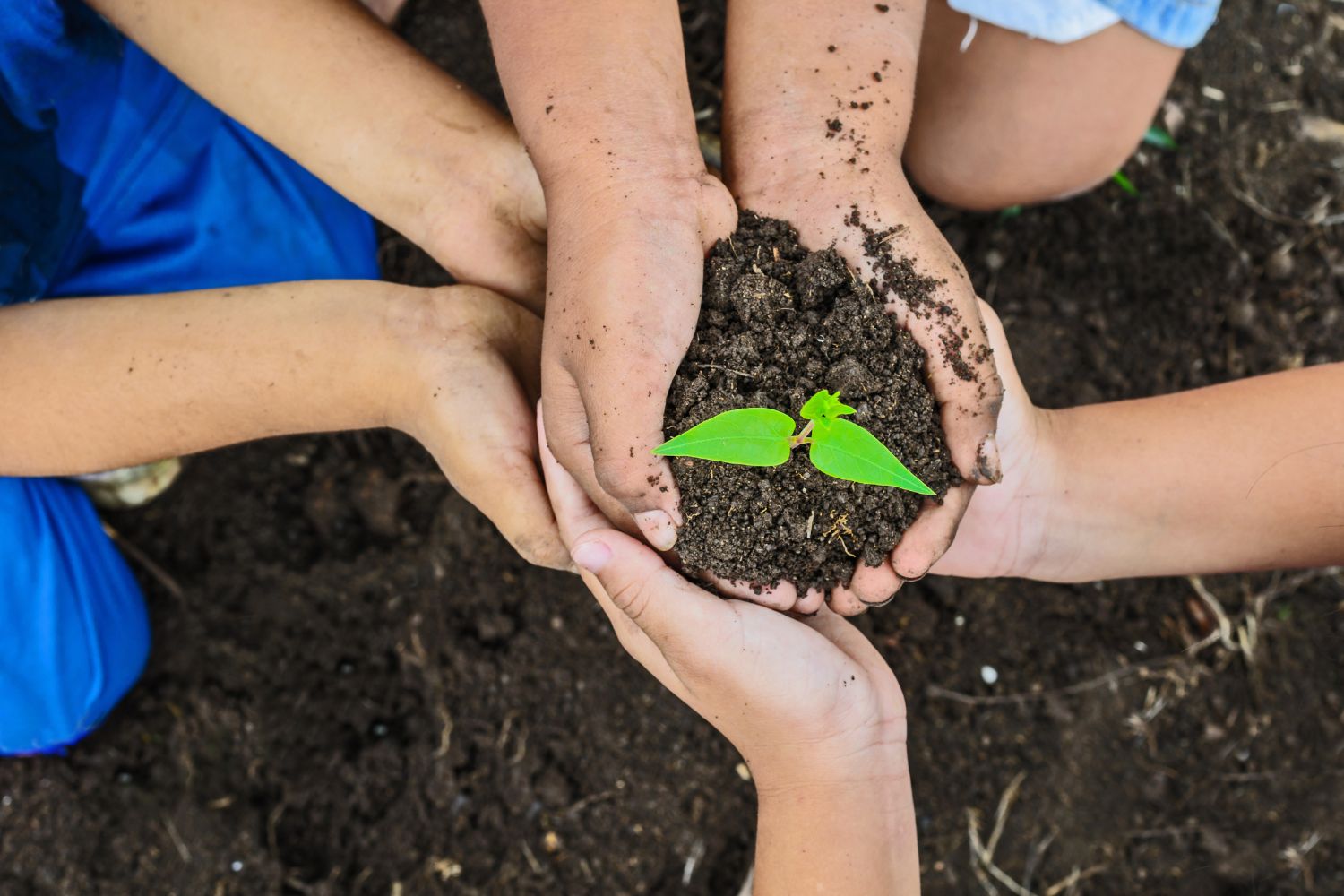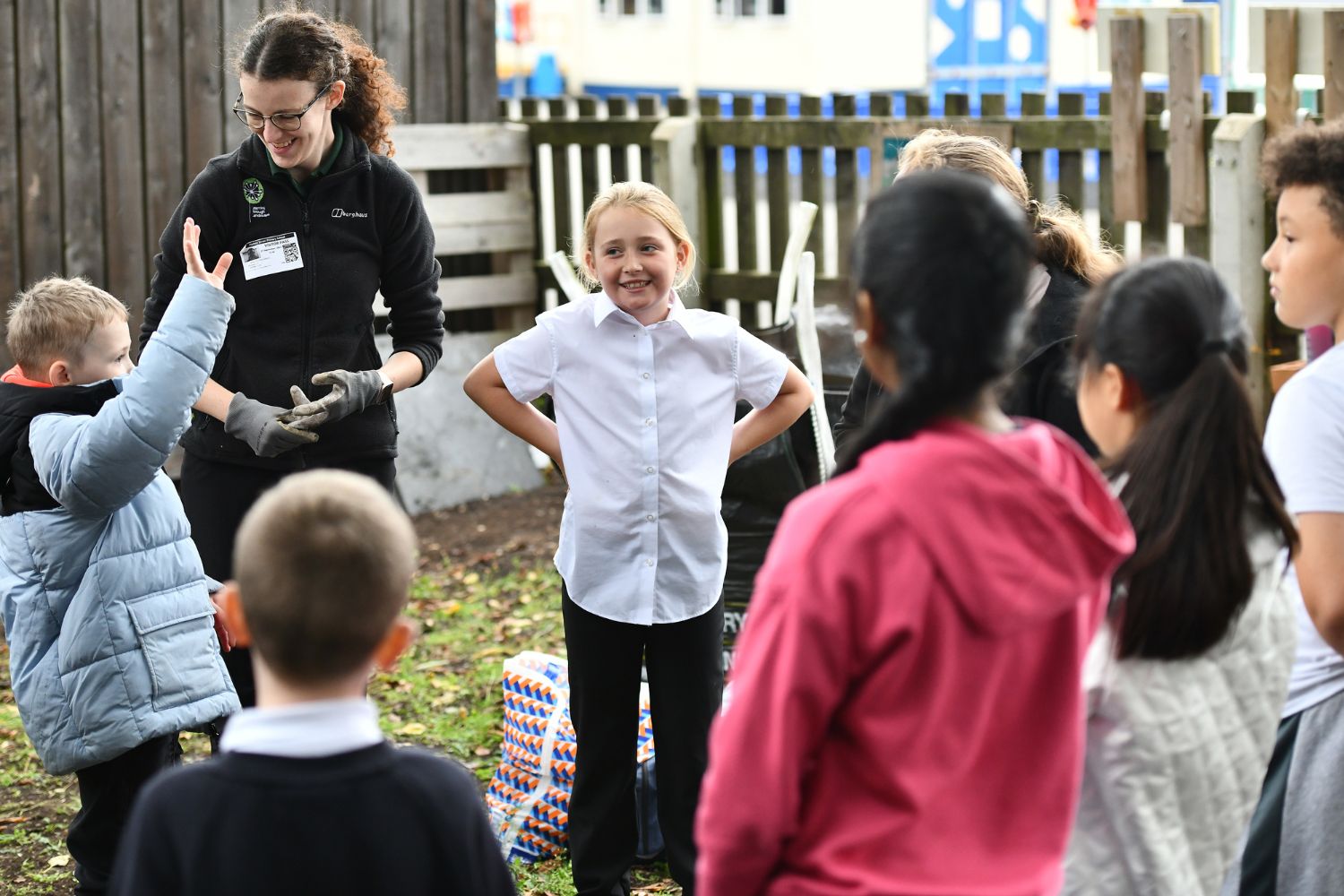Climate action: The impacts of outdoor learning and play
Find out how learning and playing outdoors can encourage climate action, why it matters more than ever before, and what we’re doing to help.
For over 35 years, Learning through Landscapes has worked with schools and early years settings, supporting them to make the most of their outdoor spaces and helping more children to enjoy the benefits of outdoor learning and play. We know that learning and playing outdoors enriches the curriculum, fosters a deeper connection to nature, and promotes good health and wellbeing for all learners. Despite this, children are spending less time outdoors than ever before.
In an increasingly uncertain world, our young people are facing new challenges with every year that passes. Whether it’s the rising incidence of mental health disorders or the growing 21st century problem that is climate anxiety, learning and playing outdoors can provide solutions. That’s why we’re always raising awareness of the benefits as part of our efforts to ensure that outdoor learning and play become an integral part of every school day.
In the previous post in this series, we took a deep dive into the impacts of outdoor learning and play on wellbeing. This time, we’re looking at how learning and playing outdoors promote climate action, why encouraging nature connection among children matters more than ever before, and what we’re doing to support this through our work at Learning through Landscapes.
Confronting the climate emergency head on
We’re all feeling the impacts of climate change, not only in the tangible devastation created by extreme weather events occurring with more frequency, but in the emotional strain of looking towards an increasingly uncertain future. The news can feel bleak and even scary at times, and children are particularly vulnerable to the overwhelm of climate anxiety.
As educators, we have several tools at our disposal to reduce climate anxiety among our pupils by fostering a sense of agency and empowering them to take climate action. Effective climate education is one of those indispensable tools, but the first and arguably most important step is simple, powerful, and often overlooked: going outside.
Encouraging nature connection at school
In a climate emergency, nurturing a generation that feels deeply connected to the natural world — and empowered to protect it — is critical. As our patron, Sir David Attenborough, says:
If children don’t grow up knowing about nature and appreciating it, they will not understand it. If they don’t understand it, they won’t protect it. And if they don’t protect it, who will?
Learning and playing outdoors not only help to ease climate anxiety among pupils by allowing them to enjoy the wellbeing benefits of more time outside the classroom, but also provide crucial opportunities for building connections with the natural world.
Activities like climbing trees and getting muddy are essential experiences for supporting healthy childhood development, but they also help children to form an emotional bond with the natural world by getting up close and personal with it. Studies suggest that these experiences are even directly linked to pro-environmental behaviours later in life, emphasising the importance of spending time outdoors from an early age for fostering a strong relationship with nature and laying the foundation for meaningful climate action.
After all, a generation that empathises with the natural world — a generation that sees nature as a source of joy, wonder, and refuge — is more likely to defend it fiercely in the face of threats, including climate change.
Making a difference in the local area
The first step to understanding the importance of climate action on a global level is understanding its impacts at a local level, and the ideal place to start is in the outdoor space that children interact with most: the school grounds. As our Head of Education and Communities, Mary Jackson, says:
School grounds that are nature-rich and full of things to do and places to be engage children with their environment every day. As they connect with the world around them, they begin to care for it and want to know how they can help our planet and wildlife to thrive. Hands-on outdoor learning and play forms the link between wanting to do something and not knowing how, to understanding that everyone can make a real difference by caring for the world around them — and that change can start in their school grounds.
Indeed, the school grounds present an excellent opportunity for engaging pupils with meaningful action in a place where they can observe the impacts of their efforts over time. Surveying their outdoor spaces, using the results to inform changes to the school site, and enjoying the fruits of their labour — sometimes quite literally! — create memorable outdoor learning experiences while mitigating the impacts of climate change in the school grounds and the local area. Our COO, Matt Robinson, says:
Schools themselves are not immune to climate impacts. Our School Grounds Survey in Scotland showed that over 50% of schools are already reporting challenges like overheating, flooding, and high winds. Integrating nature-based solutions — such as planting trees, creating rain gardens, or installing hedgerows — not only protects our school environments but also provides rich, low-cost learning opportunities.
The school grounds as a living classroom
At Learning through Landscapes, we know better than anyone how hands-on, experiential learning in the outdoor classroom can bring difficult concepts to life — and how the school grounds themselves are an invaluable resource for supporting understanding of climate change and biodiversity.
Through learning and playing outdoors, children can observe interconnected systems firsthand: the water cycle in action, the impact of seasonal changes, the role of pollinators in growing food. These real-world experiences not only nurture systems thinking, but this contextual learning helps pupils to grasp the broader consequences of human impacts on the environment. As Matt suggests, this is something that we can build on by actively engaging them with projects in the school grounds:
Focusing solely on global science and geographical facts risks disengaging learners. To truly prepare our pupils for the realities of climate change, climate education must go beyond textbooks and theoretical models. The most impactful learning happens through hands-on, localised projects that allow pupils to experience the complexity of climate change and adaptation in real, tangible ways. These projects engage pupils directly in climate resilience, making them active participants in shaping a sustainable future.
Our award-winning Polli:Nation project, supported by the National Lottery Heritage Fund, engaged 250 schools with learning about the importance of pollinators, transforming vast areas of school grounds into pollinator-friendly habitats. A teacher at one of the schools involved with the project told us:
The children really drove those decisions about what they wanted to spend the money on, and it was informed by what they’d learned about pollinators and how they’re supporting the local environment. They decided they wanted to buy hundreds of bulbs to plant not only within our school site, but also in the surrounding area. Seeing the benefits it’s going to have for our curriculum and their enthusiasm about why it’s so important in terms of the pollinators they learned about, it’s definitely a great decision.
Whether it’s creating habitats for wildlife, school gardening, or litter picking, activities that involve the whole school community also demonstrate that individual and collective action can make a real difference. That’s why, through projects like Climate Ready School Grounds, Climate School 180, and the National Education Nature Park, we place huge importance on involving children in making changes to their school grounds and granting them agency in decision-making.
Equipping children with the tools they need to take climate action
Of course, preparing children and young people for the difficult realities of climate change isn’t just about arming them with knowledge. As educators, we know that it is also our duty to equip pupils with the skills they need to face the challenges of the modern world.
We know that outdoor learning and play supports the development of key social and emotional skills. However, these skills are the same skills children will need to tackle the challenges of climate change in the future. For example, we know that unstructured, child-led outdoor play cultivates emotional resilience, a cornerstone for managing climate anxiety. Whether making art using natural materials or solving conflicts with classmates during games in the school grounds, playing outdoors encourages creativity, innovation, and confidence in one’s ability to adapt — all core skills for navigating a rapidly changing world.
As Matt suggests, to create solid foundations for meaningful climate action in later life, we must look beyond the confines of the classroom:
As educators, we have a unique opportunity — and responsibility — to connect learning with the lived realities of a changing climate. We need an approach that engages the head, hands, and heart, developing not just knowledge, but also practical skills and emotional connection. This is how we build functional climate literacy: the ability to understand, respond to, and act on climate challenges.
This kind of learning should be embedded across the curriculum, not confined to a single subject. When pupils are given opportunities to take meaningful action — whether through science, art, design, or citizenship — they begin to see that their learning and passion can drive real-world change. This fosters a climate of hope, where pupils feel empowered rather than overwhelmed.
Or, as one teacher participating in the Climate School 180 project at a school in South Uist put it:
I feel more confident to work through climate anxiety with children with the view that some broken things can create beautiful results.
Explore more benefits of outdoor learning and play
When children are spending less time in nature than ever before, outdoor learning and play are essential for nurturing the next generation of climate-conscious individuals. As they face down an uncertain future, it is our duty as educators to equip children and young people with the tools they need to take climate action — and not just skills and knowledge, but hope, wonder, and empathy for the natural world, too.
Next time, we’ll focus on the benefits of outdoor learning and play for attainment, exploring how learning and playing outdoors is the key to unlocking the curriculum and improving educational outcomes for many children.
Sign up to our newsletter to stay up to date with the latest outdoor learning news and opportunities, or follow us on Bluesky, Facebook, and Instagram.













